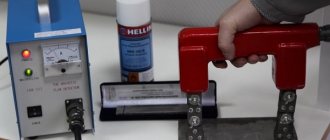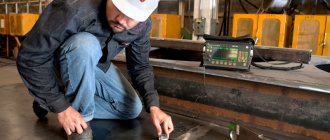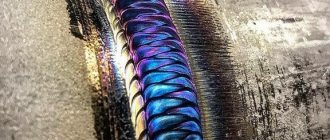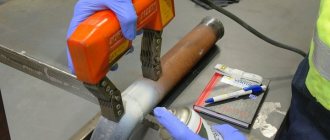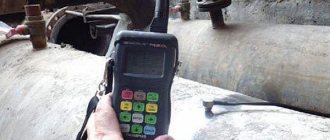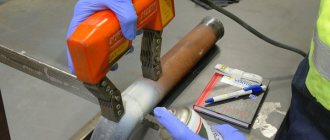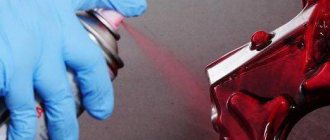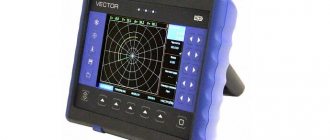Magnetic quality control of welds is a non-destructive method. The flaw detector checks finished joints and overlaps. Applicable to all types of welded joints. The flaw detector detects minor foreign inclusions: cracks, fistulas, pieces of slag, and other defects. The use of magnetic field dispersion methods is limited; for magnetic control, the metal must have a certain structure and the ability to be magnetized. Magnetic particle, magnetographic, and induction flaw detection are used only for monitoring welds on ferromagnetic alloys - carbon and low-alloy steels alloyed with cobalt, zinc, and manganese.
Magnetic non-destructive testing methods
The basis of all MC methods is the detection of local magnetic field distortions, which are caused by damage present in the magnetized product (test object). The magnetic permeability of a discontinuity (crack) is much lower than that of the object as a whole. If it is, then the magnetic lines of force are bent. So-called stray fields, or defect fields, are formed. They are fixed by various magnetic transducers (some types of transducers used give the name to the control method). By the shape and amplitude of the magnetic lines, one can understand the parameters and depth of the defect. After completing the study, the object is demagnetized using a solenoid.
GOST R 56542-2019 divides this type of non-destructive testing into the following methods (the classification is based on the method by which the initial data is obtained):
- Magnetic Powder: Magnetic powder is used as an indicator of magnetic lines. This method is used most often. It is universal, highly sensitive and easy to perform. It can be used to detect surface and subsurface (at a depth of up to 2 mm) defects.
- Induction: the magnetic fields of an object are recorded using induction transducers.
- Magnetoresistive: The magnetic field of an object is recorded using magnetoresistive transducers.
- Magnetographic: the magnetic fields of an object are recorded on a magnetic medium in the form of a signalgram.
- Ponderomotive: based on the interaction of the same name between the fixed magnetic field of an object and the magnetic field of an electromagnet, permanent magnet or current-carrying frame.
- Fluxgate: The magnetic fields of an object are recorded using fluxgate transducers.
- Hall effect method: converters of the same name are used to record magnetic fields.
Magnetic testing is regulated by Russian and international standards, including GOST R 55612-2013, GOST R 56512-2015 and EN 1290:1998.
What are weld defects?
In the Russian Federation and CIS countries, definitions of all joint defects during fusion welding of metals are designated and classified in GOST R ISO 6520-1-2012.
Weld defects are nothing more than surface or sub-surface flaws within the weld. They differ from each other in character, configuration, size and lead to a reduction in the useful life of the metal structure. They affect its user characteristics and lead to emergency situations, and therefore it is better to avoid them. A structure with defects must be urgently taken out of service for troubleshooting and subsequent restoration or disposal of the product.
The magnetic particle method for detecting connection defects helps to quickly identify defects of any type.
Factors causing defects in welded joints:
- Seams may be of poor quality if the welder does not have much experience in the work. During the procedure, the technology of electric arc, argon, and beam welding is violated. There is no preparation or heat treatment of the components, the assembly diagram of the elements is mixed up. An inappropriate mode of operation of the device for laser welding has been selected, etc.
- Poor-quality seams appear due to the use of unprofessionally produced or broken equipment for manual electric arc welding, or low-quality metal or low-cost consumables.
- The reduction in quality is greatly influenced by the melting of slag, multiple splashes of metal, contamination on the surfaces being fused and poor organization of the workplace.
All suture defects have different names and are conventionally divided into three groups, each of which has its own characteristics. There are flaws:
- external;
- internal;
- end-to-end.
The method for correcting the defects of a welded joint is determined by its characteristics. To prevent such problems in the future, the welder corrects errors independently and understands what led to unsatisfactory results. The magnetic particle testing method in this case helps to visually record these errors.
Sometimes, due to overheating, thermal deformations or changes in the strength of the metal occur that do not correspond to the design characteristics of the structure or object. More often this applies to welded joints of hardened and different composition metals. For example, when joining an austenitic stainless steel alloy with carbon steel.
Letters of gratitude from our clients
Technology
Now let’s learn more about how magnetic particle flaw detection of welds occurs. To detect a defect, it is not enough to have the right equipment. It is also necessary to use a special ferrimagnetic substance. Simply put, magnetic powder. It is applied to the weld joint using a dry or wet method.
The dry method uses a regular powdered magnetic substance. And when wet - a special magnetic suspension. In this case, the suspension is a mixture of magnetic powder and liquid. As a liquid, you can use transformer oil, its mixture with kerosene, as well as a mixture of water with substances that prevent the formation of corrosion.
It is impossible to say for sure which method is better: dry or wet. In different situations, you have to choose different methods, and sometimes even combine them. In any case, you will be able to detect even small defects, regardless of what magnetic substance you use. When using a powder or suspension, the substance simply “gathers” around the defect, forming intricate patterns if there are many defects. In this way, it is possible to accurately determine not only the location, but also the size of the defect.
A few words about the equipment. It can be very diverse: manufacturers offer compact budget models with minimal functions, but you can also buy high-tech devices with a liquid crystal display and many settings. Typically, a flaw detector is purchased based on the scope of its application. If quality control will be carried out at an offsite facility, then compactness is more important than great functionality. And if the control is carried out permanently in the workshop, then the size of the device does not play any role. In such cases, you can rely on functionality and purchase a more technologically advanced device.
Methods of applying the indicator
For magnetic powder testing, dry, wet, and paste-like indicators are used. Dry is a mixture of fine metal filings; it is applied to the surface in its natural state, without adding liquids.
The dry flaw detection method is effective for detecting discontinuities, slag inclusions on the surface or subsurface type defects. For the manufacture of magnetic particle indicators, iron scale, babbitt, magnetite, and other highly magnetizable materials are used. The field in the welded workpiece is created by a U-shaped electromagnet connected to a source of direct or alternating current with a power of 300 to 600 amperes. The ferromagnetic mixture is applied from an aerosol package, dispersed by a sieve, and directed by a bulb.
In wet indicators, magnetizable particles are suspended. They are added:
- in water with anti-corrosion substances;
- liquid soap solution;
- kerosene;
- transformer oil;
- special concentrate based on polymers.
For flaw detection, compounds are applied using several methods:
- using a brush;
- immersing in suspension;
- pouring liquid over the surface being examined.
The wet flaw detection method is used to identify surface discontinuities in welds.
Application of a flaw detector
A flaw detector is a device that is in great demand. Thanks to this non-destructive testing device, it is possible to detect visually invisible foci of corrosion (for example, under a protective coating), structural heterogeneity, hidden cavities, cavities and other discontinuities, changes in the chemical composition of alloys and other defects that arose during operation or during the manufacture of the product. Conducting flaw detection inspection in a timely manner is very important, because any imperfections and shortcomings contribute to changes in the physical properties of materials and can cause destruction of the product or structure. This is especially important at facilities where people work, because... The destruction of a structure or product can cause many casualties.
Flaw detectors are widely used in industries such as mechanical engineering, construction, energy, transport, oil and gas and chemical industries. Research centers use flaw detectors to monitor and study the properties and characteristics of solids. Using this equipment, glued and soldered joints, welds, various workpieces, parts, and finished products are monitored, both at the manufacturing stage and during operation. Some installations allow you to examine an object heated to a high temperature. Others can be used on the move. For example, a flaw detector car, bogies, and rail instruments during operation move along the rails, directly under operating conditions. There are flaw detectors that are capable of analyzing an object while it is moving. This is how pipes are checked.
How the test is carried out: stages and important technical points
The standard research scheme is the same for all types and types of welds; the sequence of magnetic particle testing of welded joints is regulated by the standards in force in this area.
Procedure for conducting the study:
Preparation of the surface to be examined. Scale, dirt, rust, and possibly lubricants, if present, are removed from the seam and heat-affected zone. In order to more accurately see the control pattern against the background of a dark metal surface, it is possible to process it with a thin layer of light (usually white) water-based paint.
The workpieces are magnetized in various ways (they are described in detail below in the corresponding section). The quality of magnetization affects the accuracy of control.
An indicator containing ferromagnet particles is applied. The application method is selected taking into account the available control devices (more details below).
For control, an inspection of the area being inspected is carried out, possibly using optical instruments specified in the standards.
The indicator pattern is deciphered, recording the defects identified during the process. For comparison, an atlas of defects is used, which contains detailed photographs. Information about shortcomings identified during magnetic particle testing of welds is entered into a special journal.
After testing, the examined part is demagnetized using the method of heating to the Curie point or the technology of placing it in a magnetic field with a damped amplitude.
Residues of the applied indicator are removed manually or using special cleaning agents.
Magnetization options
Most magnetization options are applied to parts of basic geometric shapes, and they get their name partly from these shapes:
Circular magnetization creates an even field inside the element under study, with no poles appearing at the edges.
Longitudinal, or, in other words, polar, creates a field directed along the field, with a plus at one end and a minus at the other.
Combined - in different perpendicular directions causes the emergence of multidirectional fields.
Rotating field magnetization is often used in industrial plants to evaluate the quality of a weld.
Types of electric current used for magnetization:
Constant, to form uniform induction;
Variable - more often used for simple, low-sensitivity testing techniques;
Pulse - its features are more similar to constant.
Electrospark (spark) flaw detector
Electrospark non-destructive testing devices are used to diagnose the condition of protective and insulating coatings of main pipelines (gas, oil, etc.), elements of water treatment systems, water supply systems, steam boilers, tank equipment and some other structures. The probe of the device is connected to one pole of the voltage source, and the object under study is connected to the other pole of the same high-voltage source (using a ground electrode or through the ground). During operation, the probe must touch the insulation surface (including those formed from bitumen). In places where the insulation is damaged between the probe and the product, an electrical breakdown of the air (gap) occurs. Thus, with the help of electric spark flaw detectors, the continuity of insulating and protective coatings is determined.
Thermoelectric
Often thermoelectric devices are used to determine the material (for example, steel grade) from which a structure is made. The essence of the thermoelectric control method is to measure the electromotive force at the point of contact of two dissimilar metals. The contact area is specially heated. One of the contacting materials is taken as the standard. The chemical composition of the second determines the sign and magnitude of the electromotive force at a given temperature range of the cold and hot contacts. Thus, it is possible to examine both an individual element and the entire structure.
X-ray (radiation) flaw detector
Radiation devices were first used at the Baltic shipyard in 1933. It was introduced by its inventor Mysovsky L.V. for identifying casting defects in thick metal plates.
The study is carried out using radiography. The controlled object is irradiated with neutrons, as well as alpha, beta, gamma and x-rays. Radiation sources can be betatrons, microtrons, linear accelerators, radioactive isotopes or X-ray machines. The result of this type of non-destructive testing can be a picture of a defect (radiography), a light image on the screen of a device (radioscopy, radiometry) or a signal (radiometry).
Sensitivity levels
We mentioned sensitivity above. Let's take a closer look at this topic because understanding the whole point will allow you to better understand the topic.
So, according to GOST No. 21105-87, we know that there are only three levels of sensitivity. Each level has its own letter (level A, B, C) and they all depend on the size of the defects.
Level A is the highest, sensitivity is greatest. It is possible to detect defects as small as 2.5 micrometers. Below you can see a more detailed table with information about other sensitivity levels.
You can see that the table contains a column about the maximum permissible roughness. The thing is that magnetic particle flaw detection of welded joints and the success of its implementation largely depend on the surface roughness parameter of the part. If the roughness exceeds the permissible values, the control will be less objective and accurate. But this problem can be partially corrected if you use coarse powder. It must be applied dry. Then it will be possible to detect deep defects with increased surface roughness of the part.
Materials for magnetic particle flaw detection produced by ELITES® Russia
Production of flaw detection materials for magnetic particle testing. Magnetic powder, ready-made magnetic suspension and the base for its preparation, primer paint - consumables for magnetic particle flaw detection, produced in Russia under the ELITES® brand, can be purchased from our dealers.
Indicative materials for IVD
Black and luminescent magnetic suspensions, concentrates
Suspension "Elitest ChS2"
Suspension "Elitest LS4"
Con
Means for processing the controlled surface
Primer paint. "Elitest BC5"
Elitest P10 cleaner


